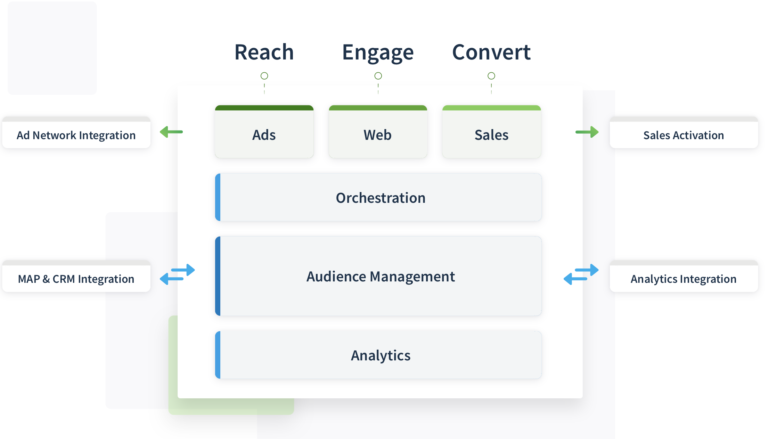By Tyler Heuple, Digital Content Specialist at Triblio
It’s better to know your next step than step where you don’t know. Oftentimes marketers and sales teams take bold lunges to attract customers, whether it be an email, an advertisement, or a cold call—and then we sit back, cross our fingers and hope that our messaging is timely and well-received. But we know it’s a shot in the dark. Going with the gut and waiting for rejection—we accept that that’s the nature of the job. But it doesn’t have to be that way.
The martech space is fast-moving and ever-changing. New technologies are constantly cropping up, making us more efficient and effective at generating demand and building pipeline.
What Is Orchestration?
At face value, orchestration is taking all the moving parts in your ABM campaign and then synchronizing them to create a cohesive strategy between sales and marketing to give buyers consistent experiences. Orchestration is not a singular this-or-that; instead, it’s a strategy that encompasses the many moving parts in your ABM campaigns.
Think of orchestration as a data-fueled car engine driven by your buyers. The first- and third-party intent data, sourced from prospective and customer account activity, fuels the engine. The engine takes in this data and subsequently keeps all your campaigns’ moving parts running in sync with each other. The wheels are turning, the gears are shifting and the engine is delivering a pleasantly consistent experience from point A to B.
Chess Not Checkers
Orchestration is dynamic in nature and it requires a work-smarter-not harder mentality to achieve its beauty. Knowing the buyer’s intent before the initial hand raise is a powerful concept. It’s a glimpse into the future of your audience’s sales cycle and enables earlier interactions with your audience. The visibility into your pipeline’s purchase intent is the predictive aspect of orchestration and the utilization of this data is what triggers multi-channel campaigns.
You may be wondering, “how can I manage all these moving parts and implement this into my ABM strategy?” The newly launched Triblio Orchestrator takes the multiple components in your account-based strategy and automatically synthesizes them to create multi-channel campaigns.

Know Your Next Move
With the insights the Triblio Orchestrator provides you, the ball is in your court to make the first strategic move to buyers. Your accounts will be properly segmented based on the buyer’s purchase signals, subsequently triggering multi-channel campaigns, that deliver the right messaging at the right time.
Where's the Proof?
Take Insperity, for example, a human resource consulting agency that utilized the Triblio Orchestrator to increase SDR efficiency rates by 500% and reduce a typical 70-day sales cycle to just 20 days from the first discovery call to close.
Their marketing team uses the Triblio Orchestrator to automatically aggregate various sources of intent data—everything from website engagement to third-party buyer signals and CRM activities. Insperity then uses this holistic view of target account interest to match high-fit, high-intent accounts to one of five messaging segments and trigger relevant intent-based sales plays.
How Will Predictive Orchestration Shape the Future of ABM?
Consider this: As more of the purchase journey goes online, larger quantities of buyer data become available, and turning that data into actionable insights becomes increasingly complex. There’s a growing gap between data collected and data used, and we’re past the point of manually parsing through tables to differentiate real purchase signals from noise.
As 21st-century marketers and sales professionals, we need a better way to close the data utilization gap and make smart campaign decisions that make an impact on pipeline. We need technology to predict, orchestrate and execute data-driven campaigns.
Earlier this month, Triblio launched the Orchestrator to address the data and campaign execution needs of modern B2B marketers. This launch, as well as Triblio’s merger with IDG this summer, were all strategic moves to help Triblio better provide more solutions that address marketers’ most pressing pain points. Since their days at Eloqua, Triblio’s co-founders, Andre Yee (CEO) and Mike Ball (CTO), have been committed to building martech to help real practitioners in the field impact revenue at their organizations. They’re excited about predictive orchestration because that’s where they see the market headed. “We see predictive orchestration as the future of ABM, and Triblio is excited to be leading the charge in bringing these innovations to the market,” said Andre Yee.
Assuming you’ve bought into all this high-level “future of ABM” talk. We’re not going to leave you hanging. To get practical tips on how to use predictive orchestration to win the best deals, register for B2BSMX today. The agenda is chock full of ABM and intent sessions, and Triblio’s Chief Customer Officer, Andrew Mahr, will be holding a lunch-and-learn on all things intent, ABM and orchestration.
Also mark your calendars for Content4Demand’s case study on Monday, October 25, at 2 p.m. ET: How Flexential Scored a Touchdown with a Campaign Built on Digital Events & Interactive Content.



